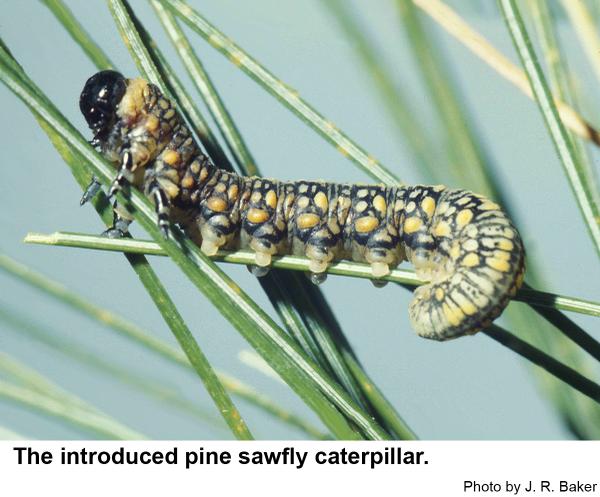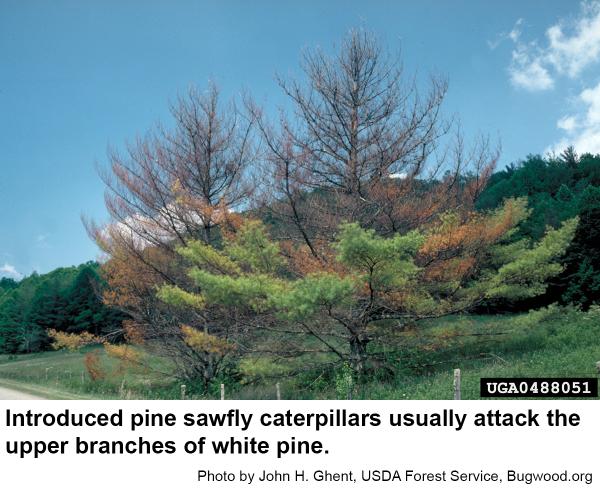Description and Biology
The introduced pine sawfly, Diprion similis, was first found in the United States in 1914. Stocky yellow and black females lay their eggs end to end by slitting open pine needles and laying the eggs inside. Male introduced sawflies have feathery antennae and are blackish and smaller than females. Each female seals the wounded needle with a frothy secretion that protects the eggs. Tiny caterpillars hatch and begin to feed gregariously on the needles. At first the outer, more tender parts of the needles are consumed so that they curl as they dry out. As the caterpillars grow, they consume the total needle. When fully grown, the caterpillar is about one inch long, and whitish with yellow and black spots and a shiny black head. The mature caterpillar crawl about and spins a tough cocoon inside of which it molts into a pupa. Cocoons are attached to needles, twigs, and bark of host trees and even on other trees nearby. Later, a new generation of sawflies emerges and repeats the life cycle. We have at least two generations each year and sometimes three. This sawfly has been reported primarily in the mountains of North Carolina.
Host Plants
The introduced pine sawfly has been reported to attack and develop upon a number of species of Pinus, especially eastern white pine, but it also infests Scot's pine, jack pine, and red pine. First generation caterpillars feed on the previous year's needles. Second generation caterpillars feed on new and old needles. Older larvae feed singly and eat entire needles and even bark after the needles are gone. Defoliation is usually most severe in the upper half of trees.
Residential Recommendations
A parasitic wasp, Exenterus amictorius, attacks mature caterpillars. Another wasp, Monodontomerus dentipes, attacks cocoons and destroys their contents. Monodontomerus is credited with keeping the introduced pine sawfly pretty much under control in North Carolina. The introduced pine sawfly is not reported to be resistant to pesticides, so most insecticides labeled for landscape use found in garden centers should give more than adequate control.
References
- The Introduced Pine Sawfly, a Defoliator of White Pine New to North Carolina. Drooz, A. T., C. A. Doggett, and H. C. Coppel. 1979. Res. Note SE-273. Asheville, NC: U.S. Department of Agriculture, Forest Service, Southeastern Forest Experiment Station. 4 p.
- Introduced pine sawfly, Diprion similis (Hartig) (Hymenoptera: Diprionidae). Anon. No Date. Forest Pest Insects in North America: a Photographic Guide.
- Sawflies. Hahn, J. and J. Lloyd. 2018 (reviewed). Yard and Garden Insects. University of Minnesota Extension.
- Extension Plant Pathology Publications and Factsheets
- Horticultural Science Publications
- North Carolina Agricultural Chemicals Manual
For assistance with a specific problem, contact your local Cooperative Extension Center.
This Factsheet has not been peer reviewed.
Publication date: Aug. 7, 2015
Revised: Sept. 24, 2019
Recommendations for the use of agricultural chemicals are included in this publication as a convenience to the reader. The use of brand names and any mention or listing of commercial products or services in this publication does not imply endorsement by NC State University or N.C. A&T State University nor discrimination against similar products or services not mentioned. Individuals who use agricultural chemicals are responsible for ensuring that the intended use complies with current regulations and conforms to the product label. Be sure to obtain current information about usage regulations and examine a current product label before applying any chemical. For assistance, contact your local N.C. Cooperative Extension county center.
N.C. Cooperative Extension prohibits discrimination and harassment regardless of age, color, disability, family and marital status, gender identity, national origin, political beliefs, race, religion, sex (including pregnancy), sexual orientation and veteran status.





